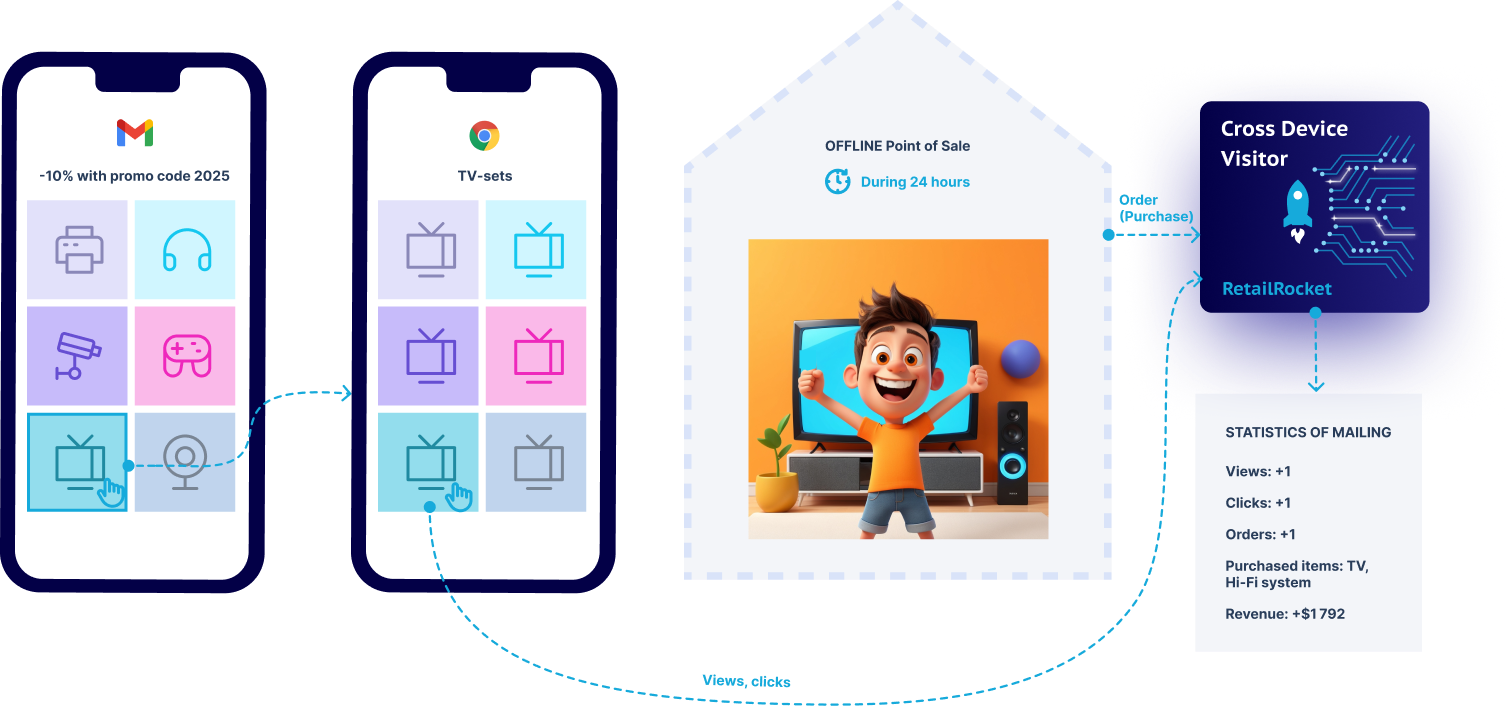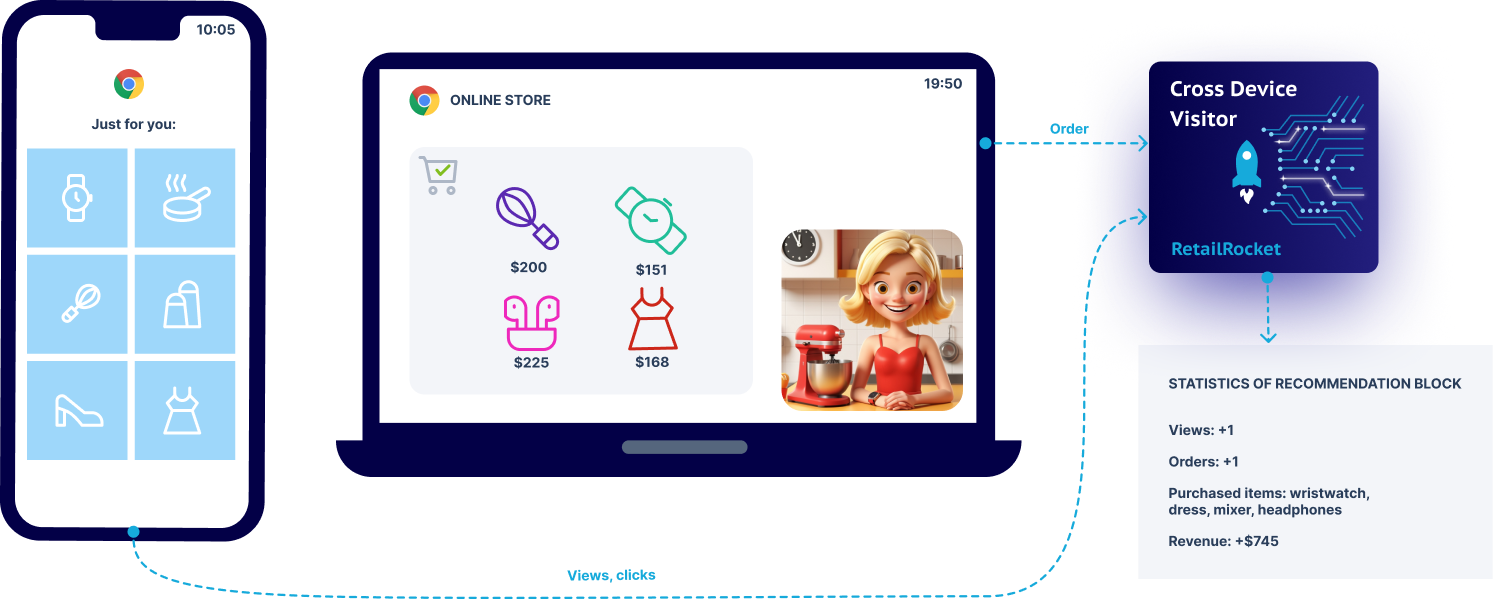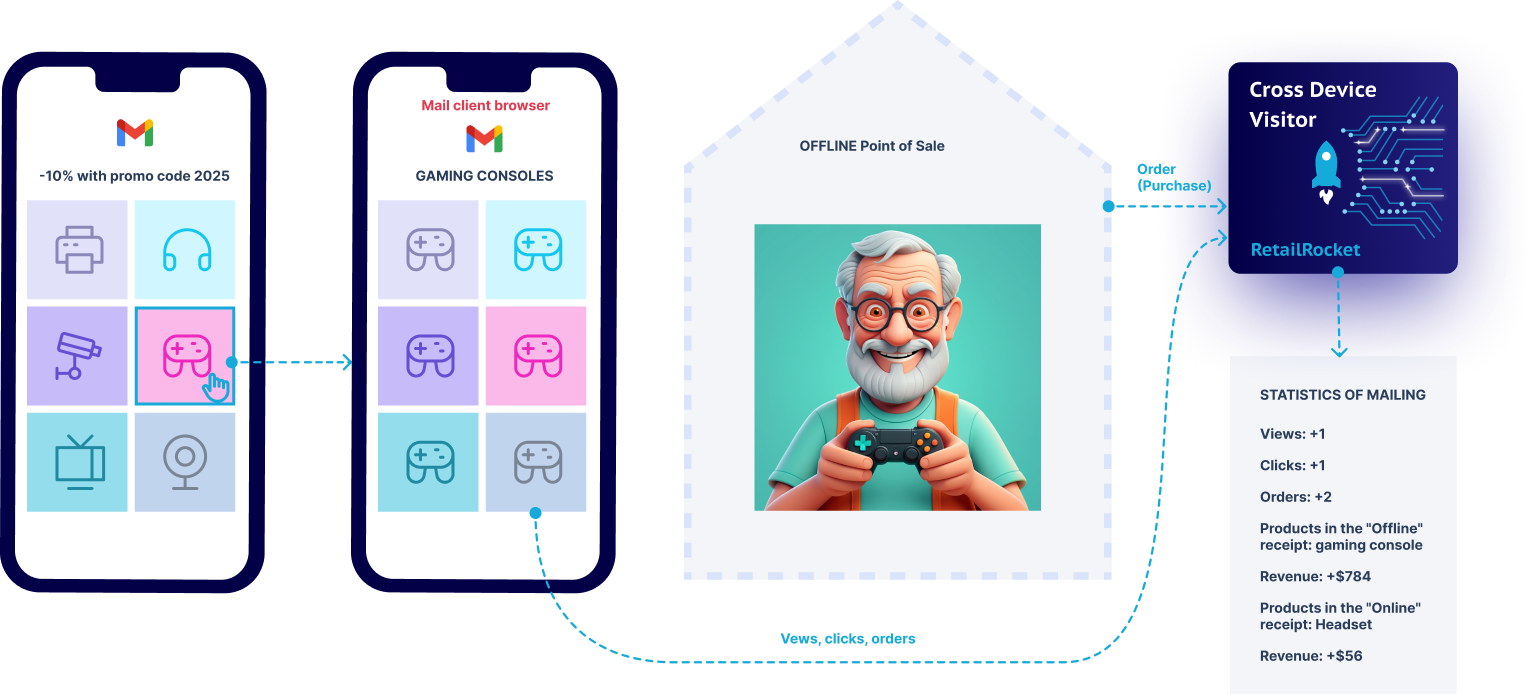Order attribution
Recommendation Blocks
Retail Rocket Traditional attribution
An order is attributed to a recommendation widget if it contains at least one product that a website or mobile app visitor interacted with through the widget within 24 hours.
Interaction is defined as a click or adding the item to the cart directly from the product card inside the recommendation widget.
For grouped products, interaction with any item in the group is taken into account. For example, a user may click on a recommended t‑shirt in one color and later order a different color — that product will still be considered sold with the involvement of the recommendation widget.
Main characteristics:
- Attribution window: 24 hours;
- What is attributed: Only the products that the user interacted with via the widget;
- Attribution persistence: Attribution is retained even if the user leaves the site and returns via a direct link or from an external source (for example, a search engine);
- Goal: A “strict” model designed to provide an accurate measurement of the real contribution of recommendations to a purchase;
Last‑Click Attribution
The “last click” attribution model credits the entire order if the user interacted with any product via a recommendation widget within 24 hours, even if that product did not become part of the final order.
This model simplifies comparing the effectiveness of Retail Rocket algorithms with other marketing tools that use the same model.
Main characteristics:
- Attribution window: 24 hours.
- What is attributed: The whole order, regardless of whether the interacted product is present in it.
- Persistence and reset of attribution:
- Attribution is preserved when the user returns via a direct link or from payment service pages.
- Attribution is reset when the user returns from an external source (for example, a search engine).
ExampleA buyer clicked on a phone case in a recommendation widget and left the store. They returned within 24 hours after the click and placed an order for a screen protector and headphones. The phone case is not in the order, but under this attribution model we will count the screen protector and headphones as attributed to the recommendation.
Differences between the models
Attribution window | 24 hours | 24 hours |
What is attributed | Only the specific products the user interacted with via the recommendation widget.
| The entire order is credited if the user interacted with any product via a recommendation widget within 24 hours. Example: clicked a phone case, later returned and ordered a screen protector and headphones — the whole order is attributed. |
Reset / expiry of attribution | Expires after 24 hours. | Expires after 24 hours or is reset when the user returns from an external source |
Purpose | Accurate measurement of recommendations’ direct influence on purchases. | Easier comparison with other marketing tools that use a last‑click model. |
Email Campaigns and web-push-notifications
An order is attributed to an email campaign if it was placed after a site visit that originated from an email, and there were no other site visits from different sources, push notifications, or emails between that email visit and the order.
Retail Rocket can identify the same visitor across different devices. This allows for tracking cross-device scenarios, such as when a user opens an email on their phone but completes the purchase on a computer, or buys a product in a physical store after viewing an email. With this approach, the system links the order to the original communication, even if the user switches devices.
Below are the core principles of order attribution for purchases originating from email campaigns and web-push notifications.
- Attribution window: 6 months from the moment of user interaction (click) with a push notification or an email. In practice, this means that if an order is placed within six months after a click from an email or push notification, and no other traffic sources (such as other emails, pushes, ads, etc.) were involved between the click and the order, the entire order is attributed to that email.
- Linking via visitorId (CDV): Retail Rocket links all user actions through a unique visitorId, consolidating them into a Cross-Device Visitor profile (CDV). This enables customer tracking across various devices.
- Attribution retention: Attribution is preserved if the user returns to the website directly (via a direct link) or from the checkout page. These cases are not treated as a change of traffic source.
- Attribution reset: If before placing an order the user visits the website via another traffic source (for example, search, social networks, or a different email), the initial attribution is canceled. The new source overrides the previous one.
- Automatic statistics: All data on such orders are automatically calculated in the Retail Rocket system based on the unified profile (CDV), provided that the necessary data are available.
Use cases
1. ROPO (Research Online, Purchase Offline)
When sales data from offline stores is uploaded, Retail Rocket determines how much recommendations and communications contributed to offline purchases.
Example: A customer receives a personalized email with product recommendations, clicks through to the website, and browses items. Hours or days later, the customer visits a physical store and buys a product (for example, a TV), providing their email or loyalty card. Retail Rocket links this purchase to the previously opened email using the user’s visitorId.

ConclusionThe order is attributed to the email channel because the user interacted with the mailing before making the purchase. For marketers this is important as it shows the contribution of email campaigns to offline sales (ROPO). It allows them to evaluate the effectiveness of mailings as part of the overall channel mix and to include offline purchases in cross-channel performance analysis.
2. Cross-device: browsing on one device, purchasing on another
The system connects user actions across multiple devices, providing a complete view of the customer journey. This is especially important for today’s buyers who often start on one device and finish on another.
Example: A user opens a newsletter on their mobile device, views a product, and clicks through. Later (e.g., the next day), they visit the website from another device (such as a desktop computer) and place an order. Retail Rocket merges the user’s actions across devices via their Cross-Device Visitor profile (CDV). As a result, even if the purchase happens on a different device, it is still attributed to the original email campaign.

ConclusionThe order is attributed to the email channel thanks to cross-device identification (CDV). This is valuable for marketers because it ensures correct measurement of email campaign effectiveness without losing data when users switch devices.
3. In-app browsers of email clients (Gmail)
Retail Rocket's attribution correctly handles the behavior of email clients, like Gmail, which often open links inside in-app browsers.
Example: A user opens an email in the Gmail or another mail-client, mobile app and clicks a product link. The transition happens in the built-in browser of the email client, but Retail Rocket records the event as an email click. The customer then completes a purchase on the website. Even though the browser was “internal”, the transition is still counted as originating from email and correctly attributed to the email channel.

ConclusionThe order is attributed to the email campaign because Retail Rocket recognized the click as coming from the mailing, even inside an in-app browser. This matters since many users open newsletters through mobile email apps. Correct attribution ensures these transitions are counted and the contribution of email campaigns to sales is measured accurately.
Updated about 1 month ago
